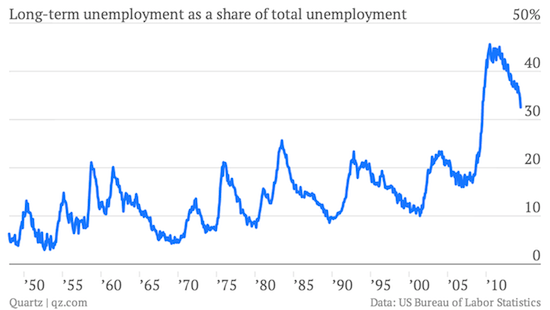5 Things You Need to Know About This Morning’s Pretty Good Employment Report
 According to the Bureau of Labor Statistics report this morning, the U.S. economy added 288,000 jobs in June. That’s the fifth straight month of +200K job growth, bringing the unemployment rate down to 6.1%, the lowest since September 2008 (April and May’s decent job numbers were both revised upward). The economy has averaged 230,000 new jobs per month, an increase on 2013, and the best continuous stretch since the 1990s tech boom.
According to the Bureau of Labor Statistics report this morning, the U.S. economy added 288,000 jobs in June. That’s the fifth straight month of +200K job growth, bringing the unemployment rate down to 6.1%, the lowest since September 2008 (April and May’s decent job numbers were both revised upward). The economy has averaged 230,000 new jobs per month, an increase on 2013, and the best continuous stretch since the 1990s tech boom.
But as you should know by now, no jobs report is ever as simple as “good” or “bad.” Here’s how to read it:
The Economy Added Jobs for the “Right” Reasons
Some of the fall in the post-recession unemployment rate has actually been bad news, as the U3 unemployment rate measures the percentage of people looking for a job who can’t find one, not those of working age without work; when people stop looking for work, in other words, the unemployment rate goes down, not because they found a job but because they dropped out of the labor market.
Not so this time around: per Jared Bernstein, the U3 rate fell for the “right” reason: “not more people leaving the labor force, but more people getting jobs.”
The labor force participation rate, while historically low (in part due to boomers aging out of the market) held steady at 62.8% this month. Again, that’s still low, but if people aren’t flooding the labor market, neither are they dropping out of it.
Many of the Gains Are Part-Time
Don’t celebrate completely: two-thirds of the month’s gains are part-time jobs. “Some economists expect employers to draw on this pool of partially employed workers as the economy continues to expand,” the Upshot’s Binyamin Applebaum wrote. “Others, however, argue that at least some of these workers will not be able to find full-time work because of their shortcomings or because the economy is shifting toward part-time jobs.”
In other words, the unemployment rate may be back at a 2008 level, but the economy it represents is weaker.
Long-term Unemployment Is Dropping
Long-term unemployment is an important metric for watching the health of the economy, as long-term unemployment both decreases chances of finding work and sets back the unemployed financially for years to come. So while the long-term unemployed rate is still historically high, it’s heartening to see it dropping. Graph via Quartz:

In addition, “the median duration of unemployment fell to 13.1 weeks from 14.6 weeks in May, the lowest in more than five years.”
Wages Rose Without Surging
“Just as important as the general jobs created number,” Business Insider’s Joe Weisenthal wrote just before the numbers were released, is the gains in wages: “If wages are surging, that means the labor market is getting tight, and that tightness means potential inflation.”
The wage numbers are encouraging, then: hourly wages rose 0.2%, up 2% over last year, in pace with inflation.
Is Obamacare Affecting the Recovery?
There’s evidence in there for either view. Per GOP rhetoric, the ACA was supposed to flush the economy down the toilet; that certainly isn’t happening. However, the shift toward part-time jobs, while part of a much longer trend, gives ammunition to the argument that the ACA’s employer mandate is causing companies to reduce hours below the 30-hour threshold.
[Image via screengrab]




